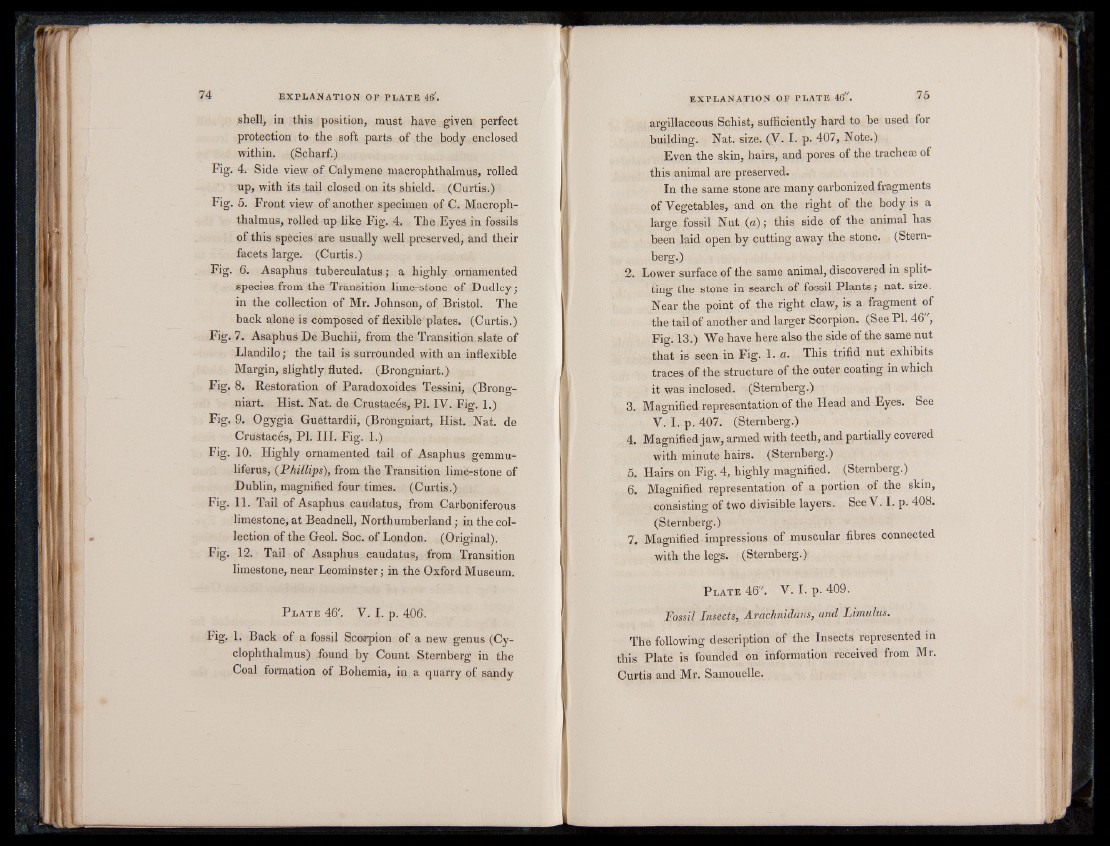
shell, in this position, must have given perfect
protection to the soft parts of the body enclosed
within. (Scharf.)
Fig. 4. Side view of Calymene macrophthalmus, rolled
up, with its tail closed on its shield. (Curtis.)
Fig. 5. Front view of another specimen of C. Macrophthalmus,
rolled up like Fig. 4. The Eyes in fossils
of this species are usually well preserved, and their
facets large. (Curtis.)
Fig. 6. Asaphus tuberculatus ; a highly ornamented
species from the Transition lime-stone of Dudley ;
in the collection of Mr. Johnson, of Bristol. The
back alone is composed of flexible plates. (Curtis.)
Fig. 7. Asaphus De Buchii, from the Transition slate of
Llandilo ; the tail is surrounded with an inflexible
Margin, slightly fluted. (Brongniart.)
Fig. 8. Restoration of Paradoxoides Tessini, (Brongniart.
Hist. Nat. de Crustacés, PL IV. Fig. 1.)
Fig. 9. Ogygia Guettardii, (Brongniart, Hist. Nat. de
Crustacés, PI. III. Fig. 1.)
Fig. 10. Highly ornamented tail of Asaphus gemmu-
liferus, {Phillips), from the Transition lime-stone of
Dublin, magnified four times. (Curtis.)
Fig. 11. Tail of Asaphus caudatus, from Carboniferous
limestone, at Beadnell, Northumberland ; in the collection
of the Geol. Soc. of London. (Original).
Fig. 12. Tail of Asaphus caudatus, from Transition
limestone, near Leominster ; in the Oxford Museum.
P late 46'. V. I. p. 406.
Fig. 1. Back of a fossil Scorpion of a new genus (Cy-
clophthalmus) found by Count Sternberg in the
Coal formation of Bohemia, in a quarry of sandy
argillaceous Schist, sufficiently hard to be used for
building. Nat. size. (V. I. p. 407, Note.)
Even the skin, hairs, and pores of the trachese of
this animal are preserved.
In the same stone are many carbonized fragments
of Vegetables, and on the right of the body is a
large fossil Nut (a); this side of the animal has
been laid open by cutting away the stone. (Sternberg.)
2. Lower surface of the same animal, discovered in splitting
the stone in search of fossil Plants; nat. size.
Near the point of the right claw, is a fragment of
the tail of another and larger Scorpion. (See PI. 46",
Fig. 13.) We have here also the side of the same nut
that is seen in Fig. 1. a. This trifid nut exhibits
traces of the structure of the outer coating in which
it was inclosed. (Sternberg.)
3. Magnified representation of the Head and Eyes. See
V. I. p. 407. (Sternberg.)
4. Magnified jaw, armed with teeth, and partially covered
with minute hairs. (Sternberg.)
5. Hairs on Fig. 4, highly magnified. (Sternberg.)
6. Magnified representation of a portion of the skin,
consisting of two divisible layers. See V. I. p. 408.
(Sternberg.)
7. Magnified impressions of muscular fibres connected
with the legs. (Sternberg.)
P late 46". V. I. p. 409.
Fossil Insects, Arachnidans, and Limulus.
The following description of the Insects represented in
this Plate is founded on information received from Mr.
Curtis and Mr. Samouelle.